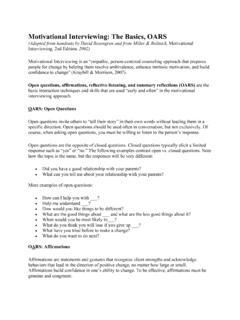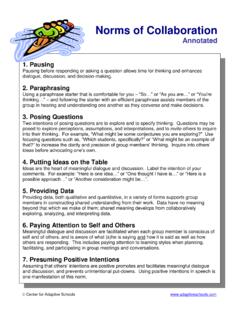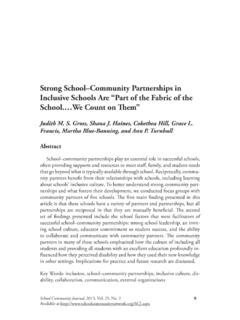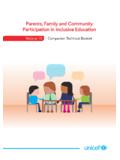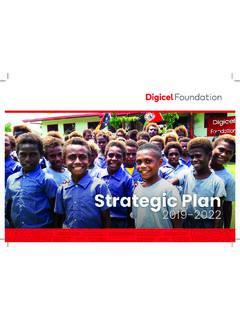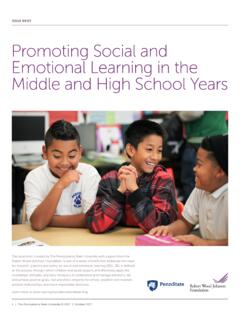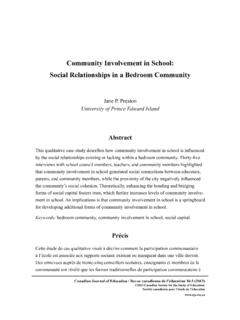Transcription of Benefits of Inclusive Education for ALL Students
1 The SWIFT Center provides the necessary framework to enable all < strong >Studentsstrong > to receive maximum educational benefit through the provision of intensive technical assistance to schools, districts, and states. The point of public < strong >Educationstrong > is giving < strong >Studentsstrong > a foundation of learning that will help them build a career later in life. Thirty years of research shows us that when all < strong >Studentsstrong > are learning together (including those with the most extensive needs) AND are given the appropriate instruction and supports, ALL < strong >Studentsstrong > can participate, learn, and excel within grade-level general < strong >Educationstrong > cur-riculum, build meaningful social relationships, achieve positive behavioral outcomes, and graduate from high < strong >schoolstrong > , college and beyond.
2 How do we transform < strong >Educationstrong > to achieve these goals? According to the research, it takes administrative leadership, multi-tiered systems of support, family and < strong >communitystrong > < strong >partnershipstrong > , an < strong >Inclusivestrong > edu-cational framework including organizational structure and < strong >schoolstrong > culture, and policies and practices providing the backbone to these of < strong >Inclusivestrong > < strong >Educationstrong > for ALL < strong >Studentsstrong > : < strong >Studentsstrong > without disabilities made significantly greater progress in reading and math when served in < strong >Inclusivestrong > settings. (Cole, Waldron, Majd, 2004) < strong >Studentsstrong > who provided peer supports for < strong >Studentsstrong > with disabilities in general < strong >Educationstrong > classrooms demonstrated positive academic outcomes, such as increased academic achievement, assignment completion, and classroom participation.
3 (Cushing & Kennedy, 1997)No significant difference was found in the academic achievement of < strong >Studentsstrong > without disabilities who were served in classrooms with and without inclusion. (Ruijs, Van der Veen, & Peetsma, 2010; Sermier Dessemontet & Bless, 2013)Kalambouka, Farrell, and Dyson s (2007) meta-analysis of < strong >Inclusivestrong > < strong >Educationstrong > research found 81% of the reported outcomes showed including < strong >Studentsstrong > with disabilities resulted in either positive or neutral effects for < strong >Studentsstrong > without disabilities. Time spent engaged in the general < strong >Educationstrong > curriculum is strongly and positively correlated with math and reading achievement for < strong >Studentsstrong > with disabilities. (Cole, Waldron, & Majd, 2004; Cosier, Causton-Theoharis, & Theoharis, 2013) < strong >Studentsstrong > with intellectual disabilities that were fully included in general < strong >Educationstrong > classrooms made more progress in literacy skills compared to < strong >Studentsstrong > served in special schools.
4 (Dessemontet, Bless, & Morin, 2012) < strong >Studentsstrong > with autism in < strong >Inclusivestrong > settings scored significantly higher on academic achievement tests when compared to < strong >Studentsstrong > with autism in self-contained settings. (Kurth & Mastergeorge, 2010)DC-CAS Reading and Math achievement gaps between < strong >Studentsstrong > with IEP s and their peers in three enculturated of district Academic Performance Indices (API) to < strong >Studentsstrong > with Domains and Core FeaturesAdministrative Leadership: strong and Engaged Site LeadershipStrong and engaged site leadership is a key component for developing and sustaining < strong >Inclusivestrong > < strong >schoolstrong > practices. (Ainscow & Sandhill, 2010; Waldron & McLeskey, 2010) strong Educator Support SystemThe principal plays an essential role in developing < strong >Inclusivestrong > programs at schools.
5 A case study of a principal at an effective < strong >Inclusivestrong > < strong >schoolstrong > identified the following characteristics of the principals role: caring for and investing in teachers, providing opportunities for distributed leadership, and protecting teachers from the pressures of high-stakes accountability. (Hoppey & McLeskey, 2010)Multi-Tiered Systems of Support (MTSS): < strong >Inclusivestrong > Academic InstructionAn MTSS framework should be used to guide instruction, by using effective general < strong >Educationstrong > strategies with all < strong >Studentsstrong > and increasing the level of support for some < strong >Studentsstrong > based on needs identified through screening and progress monitoring. (Copeland & Cosbey, 2008; Sailor, 2009a, 2009b) < strong >Inclusivestrong > Behavior InstructionImplementing < strong >schoolstrong > -wide Positive Behavioral Interventions and Supports resulted in decreases in office discipline referrals, suspensions, and disruptive behaviors and increases in pro-social behavior (Bradshaw, Mitchell, & Leaf, 2010; Sailor, Wolf, Choi, & Roger, 2009; Sailor et al.)
6 , 2006) Integrated < strong >Educationstrong > Framework:Fully Integrated Organizational StructureFully integrated organizational structures allow all < strong >Studentsstrong > who need additional supports to benefit from resources that otherwise would only available to segregated populations of < strong >Studentsstrong > (Sailor, 2009a). strong and Positive < strong >schoolstrong > Culture Schools have cultures, and research from educational anthropologists ( , Ogbu, 1982, 1985) has shown repeatedly that the culture of schools is a strong influence on academic achievement. (Sailor, 2009a, p. 250) Family and < strong >communitystrong > Engagement:Trusting Family PartnershipsStudent achievement in the elementary grades (Goddard, Tschannen-Moran, & Hoy, 2001), middle < strong >schoolstrong > grades (Sweetland & Hoy, 2000), and high < strong >schoolstrong > grades (Hoy & Tarter, 1997) is likely to be higher in schools in which trusting partnerships exist than in schools in which partnerships and trust do not < strong >communitystrong > Partnerships Research indicates that when a collective group of < strong >schoolstrong > , family, and < strong >communitystrong > stakeholders work together, achievement gaps decrease.
7 (Bryan & Henry, 2012, p. 408) < strong >Inclusivestrong > Policy Structure and Practice: strong LEA/ < strong >schoolstrong > RelationshipA strong and supportive relationship between individual schools and their districts is critical for sustainable < strong >schoolstrong > reform. (McLaughlin & Talbert, 2003)LEA Policy FrameworkA policy framework must exist at the < strong >schoolstrong > , district, state, and federal levels that is fully aligned with < strong >Inclusivestrong > reform initiatives and removes barriers to successful implementation. (Kozleski & Smith, 2009)ReferencesAinscow, M., & Sandhill, A. (2010). Developing < strong >Inclusivestrong > < strong >Educationstrong > systems: the role of organisational cultures and leadership. International Journal of < strong >Inclusivestrong > < strong >Educationstrong > , 14(4), , C. P., Mitchell, M.
8 M., & Leaf, P. J. (2010). Examining the effects of < strong >schoolstrong > wide positive behavioral interventions and supports on student outcomes: Results from a randomized controlled effectiveness trial in elementary schools. Journal of Positive Behavior Interventions, 12(3), , J., & Henry, L. (2012). A model for building < strong >schoolstrong > -family- < strong >communitystrong > partnerships: Principles and process. Journal of Counseling and Development, 90(4), , C. M., Waldron, N., & Majd, M. (2004). Academic progress of < strong >Studentsstrong > across < strong >Inclusivestrong > and traditional settings. Mental Retardation, 42(2), , S. R., & Cosbey, J. (2008). Making progress in the general curriculum: Rethinking effective instructional practices. Research and Practice for Persons with Severe Disabilities, 33(4), , M.
9 , Causton-Theoharis, J., & Theoharis, G. (2013). Does access matter? Time in general < strong >Educationstrong > and achievement for < strong >Studentsstrong > with disabilities. Remedial and Special < strong >Educationstrong > , 34(6), , L. S., & Kennedy, C. H. (1997). Academic effects of providing peer support in general < strong >Educationstrong > classrooms on < strong >Studentsstrong > without disabilities. Journal of Applied Behavior Analysis, 30(1), , R. S., Bless, G., & Morin, D. (2012). Effects of inclusion on the academic achievement and adaptive behaviour of children with intellectual disabilities. Journal of Intellectual Disability Research, 56(6), , R. D., Tschannen-Moran, M., & Hoy, W. K. (2001). A multilevel examination of the distribution and effects of teacher trust in < strong >Studentsstrong > and parents in urban elementary schools.
10 The Elementary < strong >schoolstrong > Journal, , D., & McLeskey, J. (2010). A case study of principal leadership in an effective < strong >Inclusivestrong > < strong >schoolstrong > . The Journal of Special < strong >Educationstrong > , 46(4), , W. K., & Tarter, C. J. (1997). The road to open and healthy schools: A handbook for change. Thousand Oaks, CA: Corwin , A., Farrell, P., & Dyson, A. (2007). The impact of placing pupils with special educational needs in mainstream schools on the achievement of their peers. Educational Research, 49(4), , E. B., & Smith, A. (2009). The complexities of systems change in creating equity for < strong >Studentsstrong > with disabilities in urban schools. Urban < strong >Educationstrong > , 44, 427-451. Recognized: (1) American < strong >Educationstrong > Research Association, Special Interest Group, Systems Change: Best scholar-practitioner article on systemic change.



